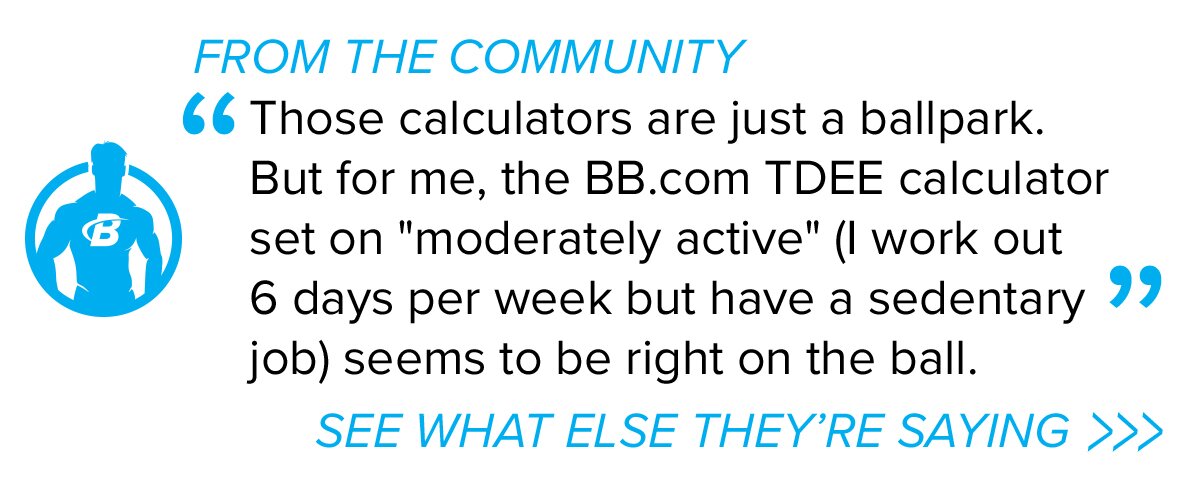
TDEE Calculator: Calculate Your Maintenance Calories
Figuring out your ideal number of calories starts with knowing how many you burn right now! This calculator will help you get more systematic about eating for your goals!
Trying to dial in your nutrition for your physique or athletic goals? Then you need to know your current total daily energy expenditure (TDEE), or the number of calories you burn each day. Eat more than this amount and you can expect to gain weight. Eat less than this amount and you'll set yourself up to lose weight.
This calculator will give you a customized estimate based on your age, your unique body, and your activity level. That last part is crucial! If you work on your feet every day and train hard 5 times a week, the number of calories you burn will be dramatically different than someone who works behind a desk and trains 3 days a week.
Once you have your number, you can use it to determine how many calories to eat daily to lose or gain weight, or to maintain your weight.
TDEE Calculator
This number represents the approximate number of calories you burn each day, or what is known as "maintenance" calories. Here are your next steps to adjust your weight:
1. Pick a workout plan.
A well-designed program is an essential part of turning hard numbers like calories into hard-body results! Here are the most popular weight-loss plans from BodyFit:
2. Calculate your macronutrient ratio.
Your TDEE is a valuable number to know, but it doesn't take your goals into account! Bodybuilding.com's Macronutrient Calculator will provide a customized calorie recommendation for weight loss, gain, or maintenance, along with the precise number of macronutrients of protein, fats, and carbohydrates making up those calories.
3. Learn about the best fat-loss and weight-gain supplements.
Supplements can help you accelerate your results once you have your calories and training in place. Krissy Kendall, Ph.D., shares her recommendations for fat-loss in the article, "5 Ways to Up Your Fat-Loss Supplement Game." Looking to gain? Try the "8 Proven Bodybuilding Supplements for Muscle Growth and Strength."
4. Join a fitness community.
For over 10 years, members of BodySpace have been helping each other build their best bodies. Join a fitness community that knows what it takes to change!
Which Goal and Activity Level Should I Choose?
Activity Level
This choice should reflect the amount of activity in your life based on how you exercise and how physically active your life and/or job is. Nutritional researchers agree calorie estimates should take more into account than just the amount you exercise. Here's how to figure out what's right for you:
- Sedentary: You work at a desk job and you don't do much housework, walking, or exercising.
- Lightly active: You don't exercise much, but you go for walks 1-3 times per week and are on your feet doing housework during some of the day.
- Moderately active: You exercise 3-5 times a week and stay moving throughout the day with non-exercise activities.
- Very active: You exercise intensely or play vigorous sports on most days.
- Extra active: You exercise intensely or play vigorous sports nearly every day, including occasional "two a days." You also work a physical job or are on your feet most of the time.
Are TDEE Calculators Accurate?
A TDEE calculation is just an estimate. After all, the number of calories you burn is different every day! But for many people, it is close enough to help them make more informed choices about the way they eat. Use the TDEE calculator as a place to start tracking your calories, and then adjust your calories up or down based on your weight change over time
To learn more about all the fundamental ideas of nutrition and how to match your eating to your goals, dive into Bodybuilding.com's Foundations of Fitness Nutrition course.
How Do You Use Your TDEE to Lose Weight?
To lose weight, you'll need to eat fewer calories than you burn. Research shows that somewhere around 80-90 percent of TDEE is a sufficient "calorie deficit" to sustainably and safely lose weight.
To determine your number, use Bodybuilding.com's Calorie Calculator.
How Do You Use Your TDEE to Gain Weight?
To add muscular weight, you'll need to eat more calories than you burn. In the guide "How to Gain Muscular Weight," exercise physiologist Krissy Kendall, Ph.D., recommends starting at 500 calories above your TDEE, then bumping it up further as needed. That's also the number recommended by Bodybuilding.com's Calorie Calculator.
Protein is your low-calorie friend for weight loss and muscle gain. Have a shake after training, or any time of day as a meal replacement. - View All
Get Systematic About Your Results
Once you know how many calories you're burning, it's time to take the same kind of strategic method to the rest of your training and nutrition. These popular calculators can help you dial in your approach!





